The Azores. A little jungle in the middle of the Atlantic. These islands are like a blend of Hawaii, Madeira, and Indonesia, offering a bit of everything. Whether you visit the main island of São Miguel or venture elsewhere, I promise you’ll love it. In fact, National Geographic named the Azores the “Most Beautiful Place on Earth” back in 2016 – and that can’t just be a coincidence!
On our first visit, we thoroughly explored São Miguel, the “main” island, which also happens to host the largest airport.
Which island should you visit?
The Azores are made up of 9 islands, and each one is said to be completely unique. Many sources recommend visiting at least two or three of them. Unfortunately, I can’t say which one is the best since we only had time to explore the main and largest island – São Miguel.
We had 7 days in total, and if I could plan it all over again, I’d probably spend 4 days on São Miguel and 3 days on another island, instead of dedicating the full week to São Miguel.
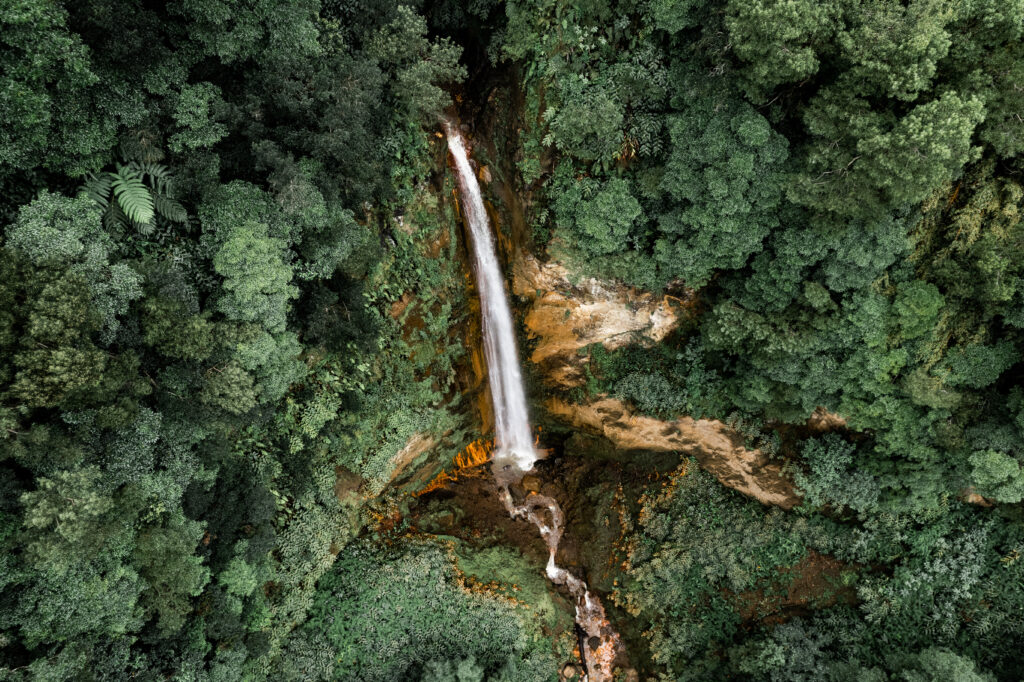
How long should you spend on São Miguel island?
It depends on how thoroughly you want to explore and what time of year you’re visiting.
7 days is the ideal amount of time if you don’t want to skip any spots or make compromises. I’d also recommend spending a full week on São Miguel if you’re visiting off-season (anytime between December and May), as the weather might not always cooperate, and you could end up stuck in your hotel for a couple of rainy days. We visited at the end of April, and the weather wasn’t exactly on our side, so we had to revisit some places when conditions improved.
4-5 days should be enough if you’re planning to visit other islands as well, or if you’re traveling to the Azores during the summer dry season with more stable weather (May to November). In 4-5 days, you can easily cover all the spots mentioned in this article.
Rent a car on São Miguel or not?
Definitely yes! The roads on São Miguel are in excellent condition, and renting a car is the fastest and most convenient way to get around the island. Besides the usual rental companies (Hertz, Avis, etc.), the local rental company Ilha Verde is a great option. They even have a desk right in the terminal, which is a big plus for me—I really don’t want to take a 20-minute shuttle ride to pick up a car.
I booked the car about three weeks in advance. Renting a car cost us 5,400 CZK for 7 days. We also got a free upgrade to a better car class. We booked the cheapest mini car but ended up with a Dacia Stepway. Just be aware that most cars have a manual transmission, and automatics come with a hefty extra charge.
It was my first time booking through Discover Cars, and I was pleasantly surprised. Everything went smoothly without a single issue.


Stay in one place or move around?
For São Miguel, staying in one place is definitely the best option—especially if you’re short on time. The island is quite small, so there’s really no need to move around. Plus, given the unpredictable weather, it’s good to stay flexible. If it’s raining in the west, you can simply head east. That’s why I recommend booking accommodation somewhere central, around Ponta Delgada. The longest drive you’ll have to take is about 1.5 hours in either direction.
We stayed at the Vale do Navio hotel in the town of Capelas, just a 12-minute drive from Ponta Delgada. And we couldn’t have picked a better location. The hotel itself wasn’t anything special, but since we mostly just used it as a place to sleep, it didn’t really matter.
What to pack?
If you’re planning to go hiking in the Azores, you’ll definitely need some hiking clothes and a daypack.
Aside from that, bring a little cash, though you probably won’t need much. Other than that, there’s nothing particularly special you need to pack. It’s one of those “Western-style” destinations where a credit card and a phone are pretty much all you need to explore the island.
What to see on São Miguel?
On São Miguel Island, you can look forward to craters, lakes, steaming geothermal spots, waterfalls, jungles, tea plantations, and dramatic cliffs. There’s so much to see, so let’s dive in!
All the spots are ranked based on how much they amazed us. Of course, this list is subjective, and since I’ve always been fascinated by volcanoes, all the viewpoints in the Sete Cidades crater area snagged the top spots.
1 Miradouro da Boca do Inferno
The most famous viewpoint on São Miguel Island offers breathtaking views of the Sete Cidades craters. However, I can’t say it was our favorite spot, and here’s why. Compared to other places on the island, this viewpoint is relatively high up, and fog often lingers here—even if the coastline is basking in blue skies or the weather forecast for Sete Cidades predicts clear conditions. During our entire 7-day stay on São Miguel, not a single minute passed without fog, so we didn’t get to see the craters from this viewpoint at all. I’ve read that this happens quite often, which supports my theory that it’s a good idea to plan a few extra days on São Miguel, just in case.
Thankfully, there’s a webcam here, so you can check the current conditions before making the trip. I recommend downloading the SpotAzores app, which shows live feeds from all the webcams across the Azores. Alternatively, the Czech weather app Windy does the trick as well. That said, the webcam is located about 200 meters lower in elevation (somewhere near the Miradouro do Cerrado das Freiras viewpoint), so even if the webcam shows clear skies, it doesn’t necessarily mean it’s clear at Miradouro da Boca do Inferno.
We learned this the hard way—once, despite being as far away from Sete Cidades as possible (on the eastern tip of the island), we saw blue skies on the webcam, made a last-minute decision to turn around, and drove 1.5 hours, only to find the fog hadn’t budged an inch.






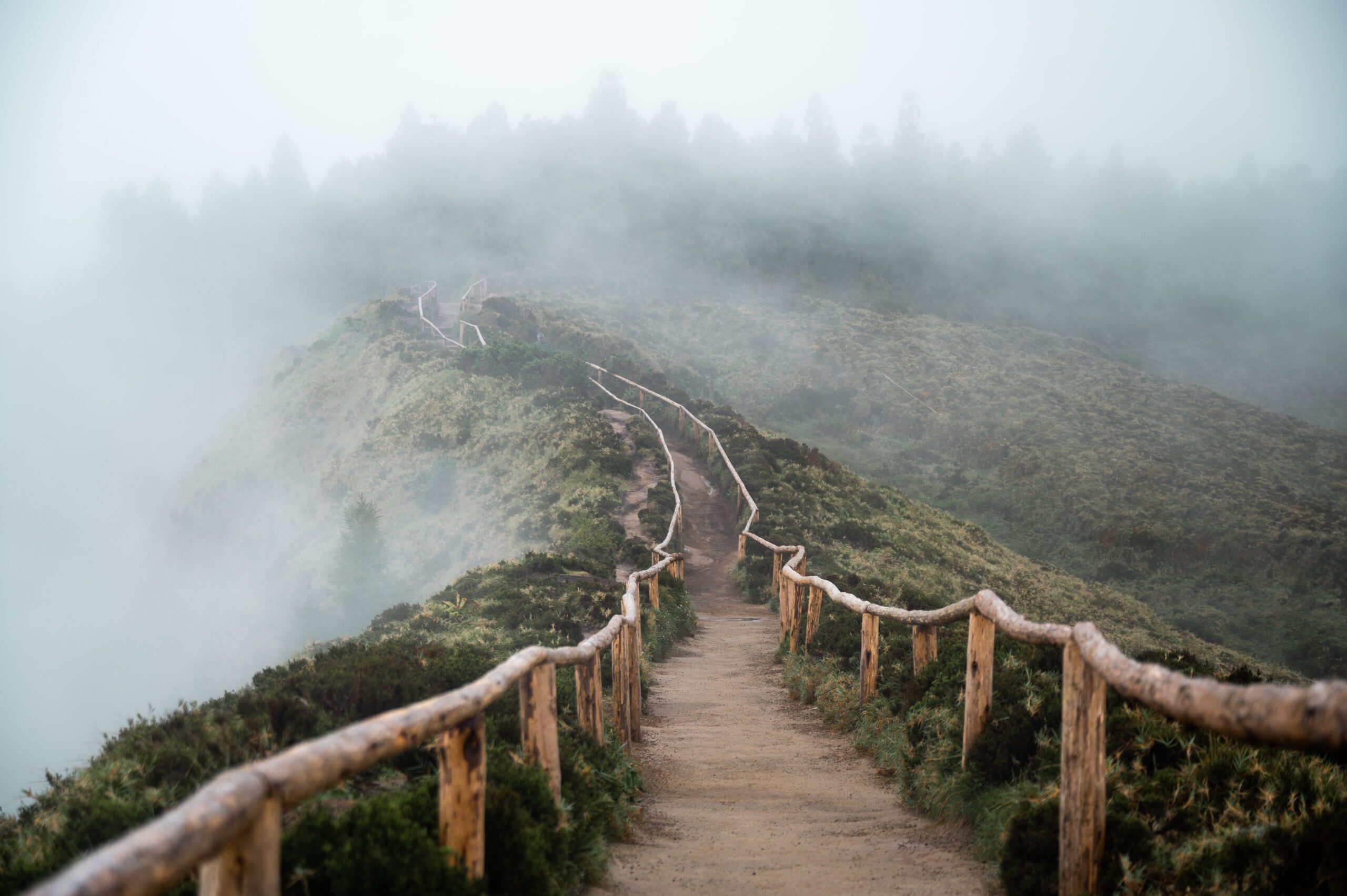
2 Miradouro do Cerrado das Freiras
The second viewpoint for observing the Sete Cidades craters is Miradouro do Cerrado das Freiras, located a few hundred meters lower in elevation. If you’re out of luck and Boca do Inferno is shrouded in fog, you can try heading down here instead. Since this viewpoint is lower, you won’t get the same dramatic bird’s-eye view of the craters; instead, you’ll see them more “flat-on,” which slightly diminishes their charm. From this angle, the water surface looks more like an ordinary lake. Still, it’s stunning thanks to its turquoise color.
Miradouro do Cerrado das Freiras is right by the road, so there’s no need for any hiking. If the weather is clear, I also recommend walking a few hundred meters back along the road to Lagoa de Santiago (the first photo in the collage below). Because this lake is smaller, the crater is much more visible. However, there’s no official viewpoint here, so be cautious and watch out for traffic!


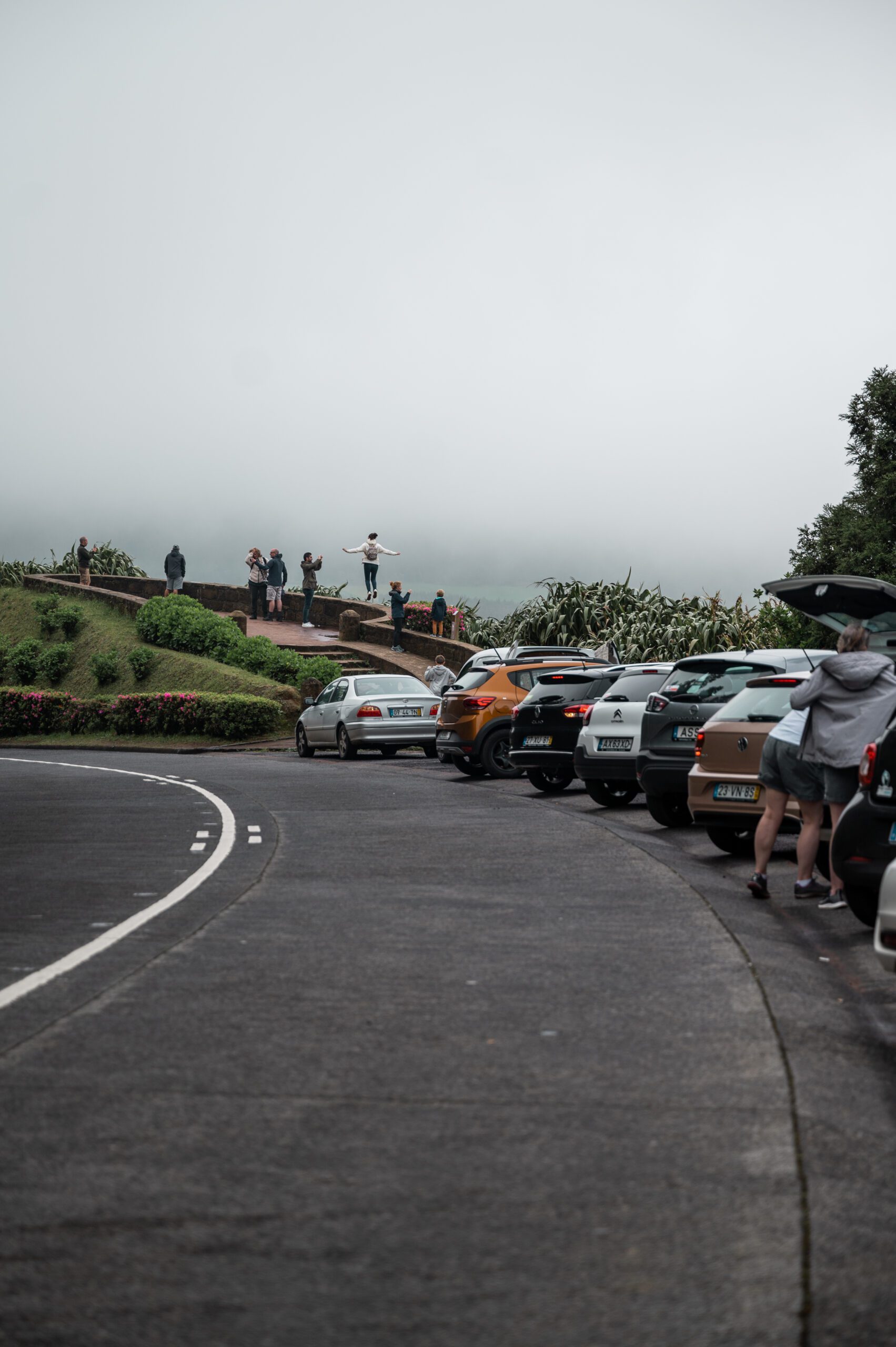


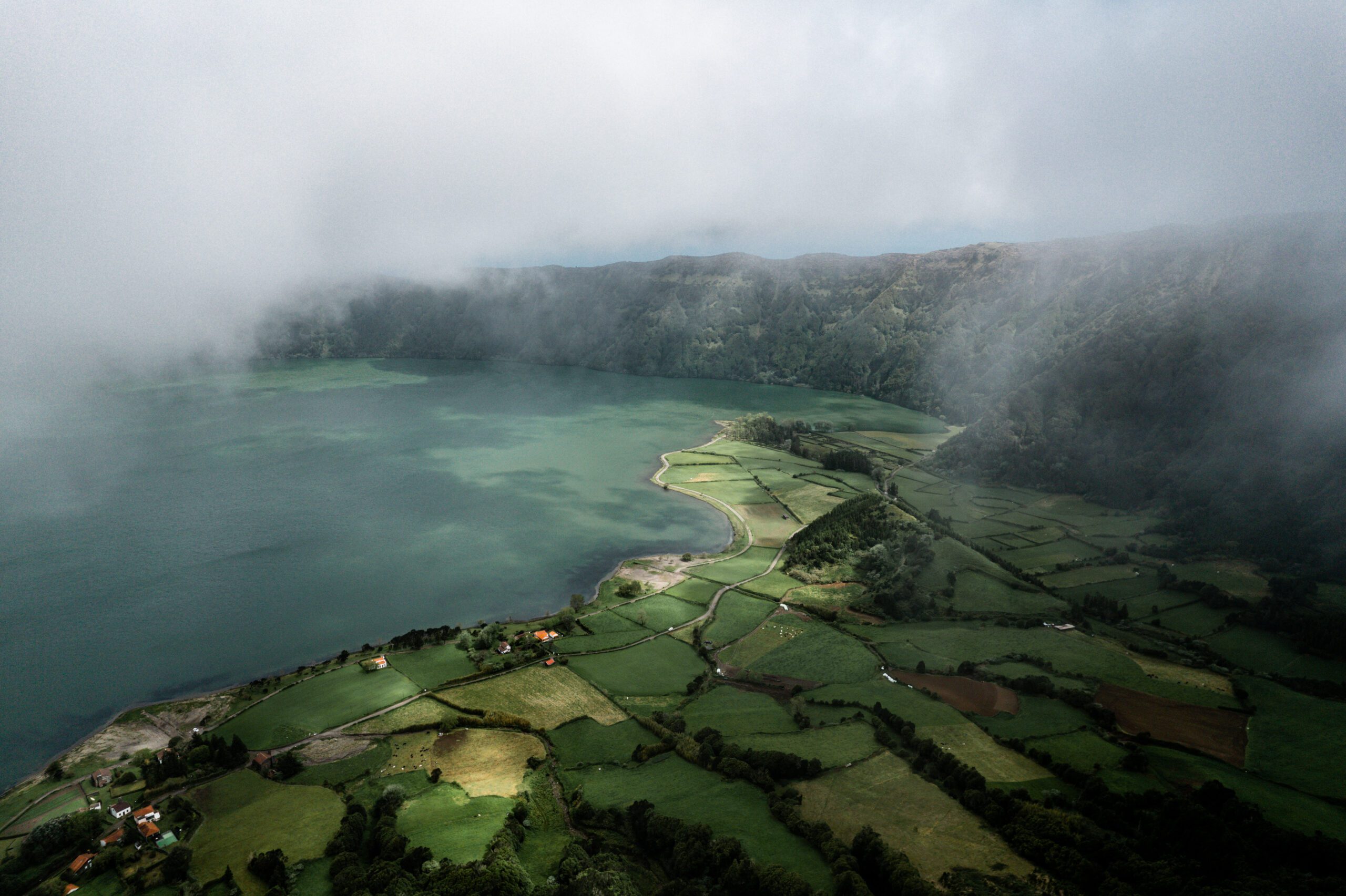
3 Miradouro do Pico do Carvão
The last viewpoint overlooking the craters is located on the opposite side of the massif, so it doesn’t face Sete Cidades. Still, it offers a gorgeous view of the landscape filled with photogenic grassy hills that are so characteristic of the Azores.
The viewpoint is right next to the road, with a large parking lot available for convenience.



4 Ilhéu de Vila Franca do Campo
Ilhéu de Vila Franca do Campo is an uninhabited islet floating in the ocean near the town of Vila Franca do Campo. It’s the remnant of a volcanic caldera, with a sandy beach nestled inside. The waters here are calm, making it a popular spot for swimming and snorkeling.
You can reach the islet by boat (some companies stop here as part of whale-watching tours), but the best view is definitely from above, where the turquoise lagoon truly stands out. During the high season, a ferry runs to the islet, but visitor numbers are limited, so it’s a good idea to book tickets well in advance.
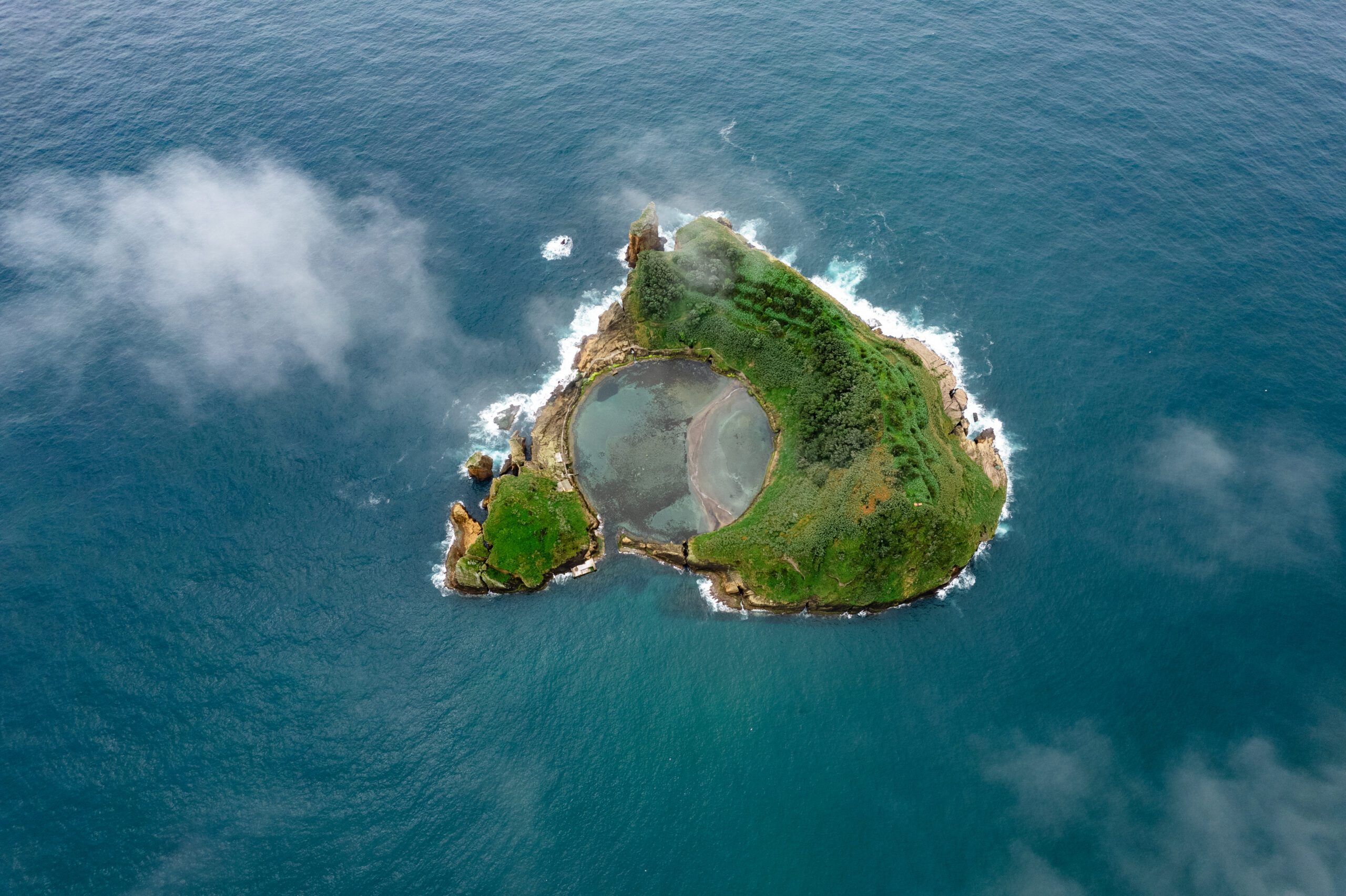
5 Miradouro do Cintrão
If you’re driving along one of the coastal roads, you’ll likely pass viewpoint after viewpoint. It can be overwhelming to decide where to stop, as you might pass 30 of them during an hour-long drive. We stopped at nearly every one—curiosity wouldn’t let us just drive by—but one, in particular, stood out as the most beautiful.
It’s a short detour off the main road, but it’s absolutely worth it. From Miradouro do Cintrão, you’ll have a stunning view of the cliffs, with a 120-meter drop below you. It’s especially magical at sunset, which is why we came back here one evening to soak it in.
The viewpoint is located right by the road, with a small parking lot available.
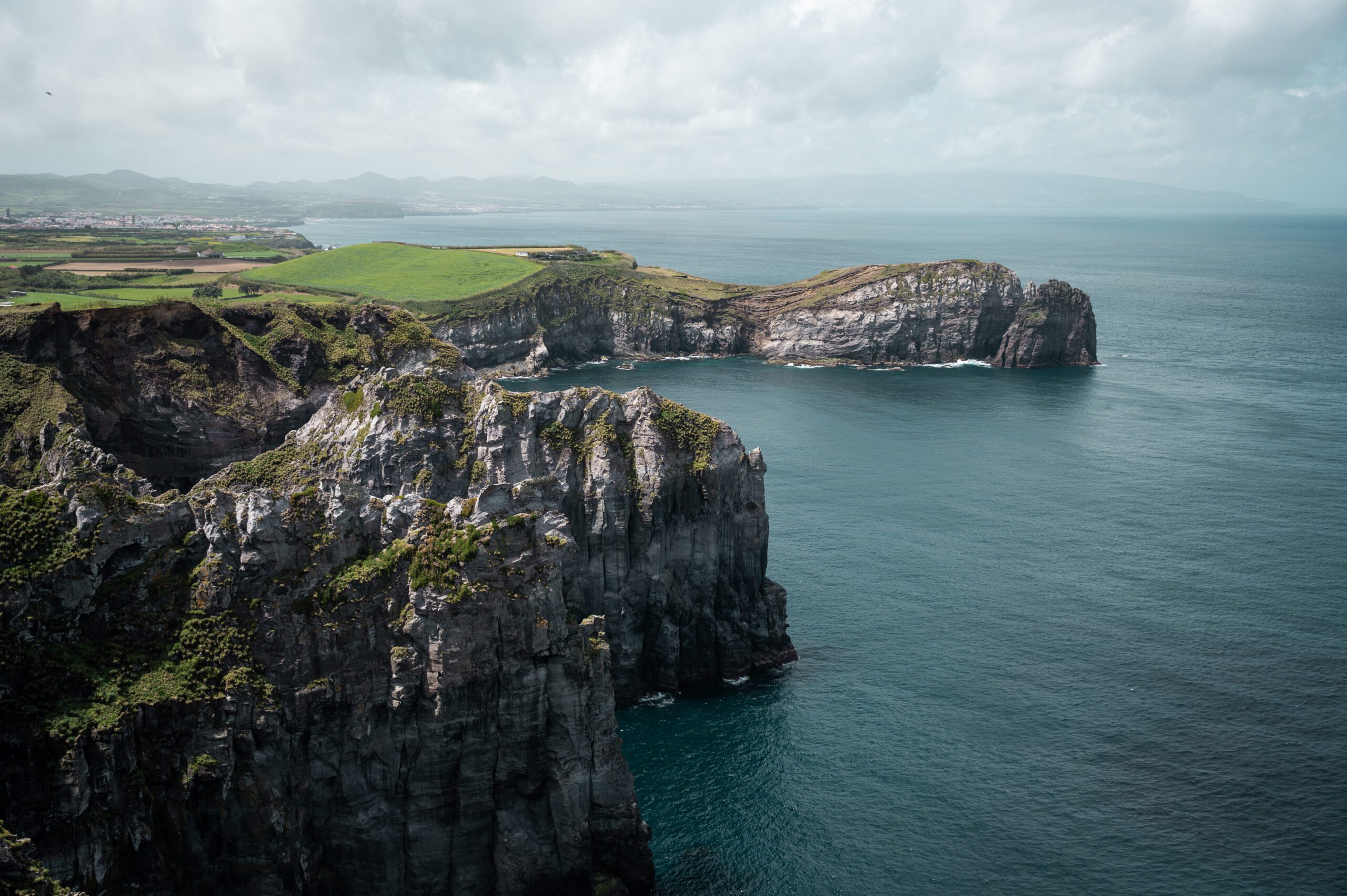




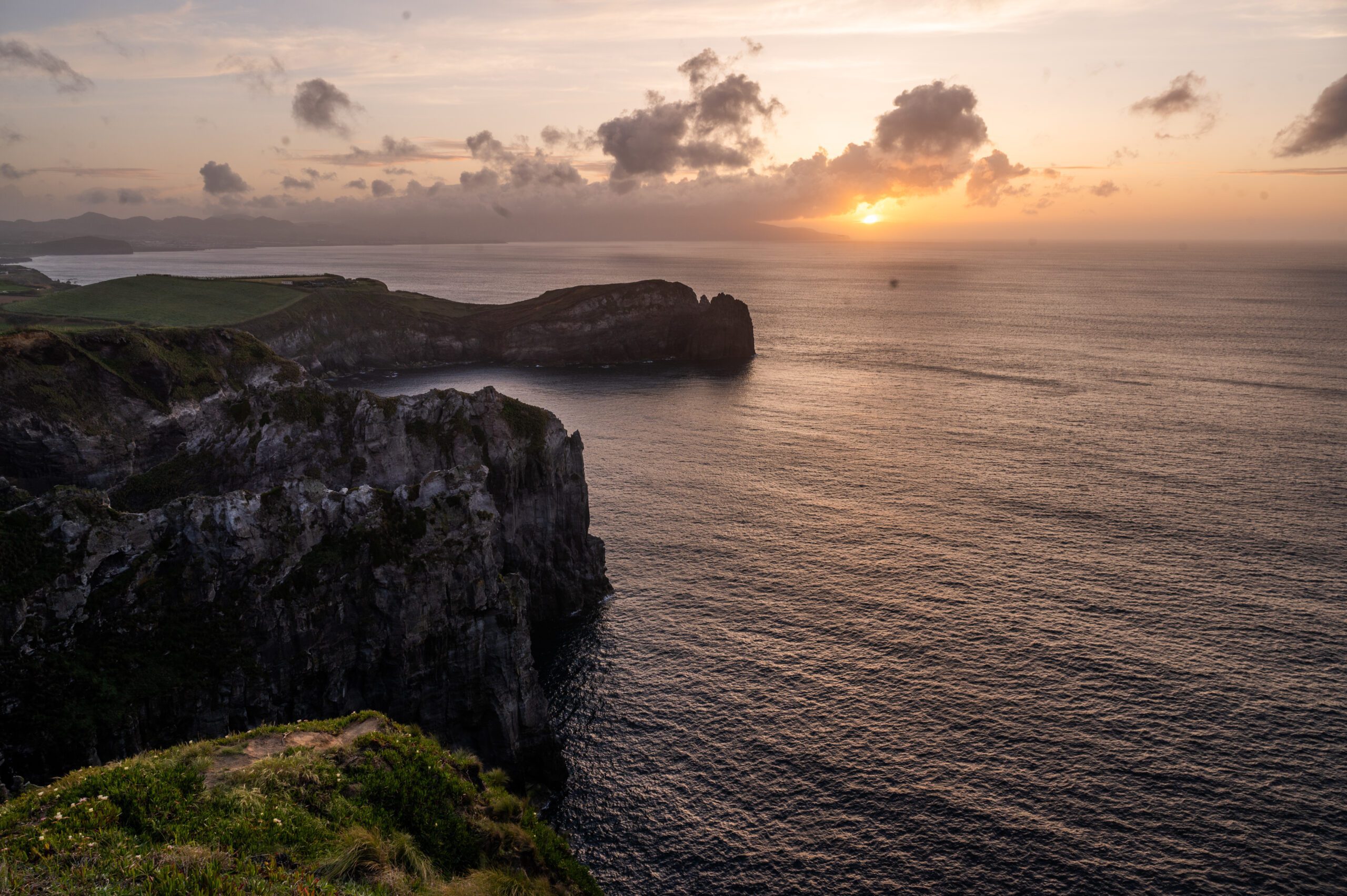
6 Cascata do Salto do Prego
Length: 1.5 km (3 km round trip)
Route link: HERE
Difficulty: Easy
There are so many waterfalls on São Miguel that it’s hard to pick the most beautiful one. Cascata do Salto do Prego might not be the tallest, but it stood out thanks to the stunning jungle trail leading to it. The lush greenery completely blew us away. Pay attention to the vegetation along the way—you’ll spot plant species that you won’t find anywhere else in the world.
P.S.: The trail was super muddy, so definitely skip the white sneakers for this one!
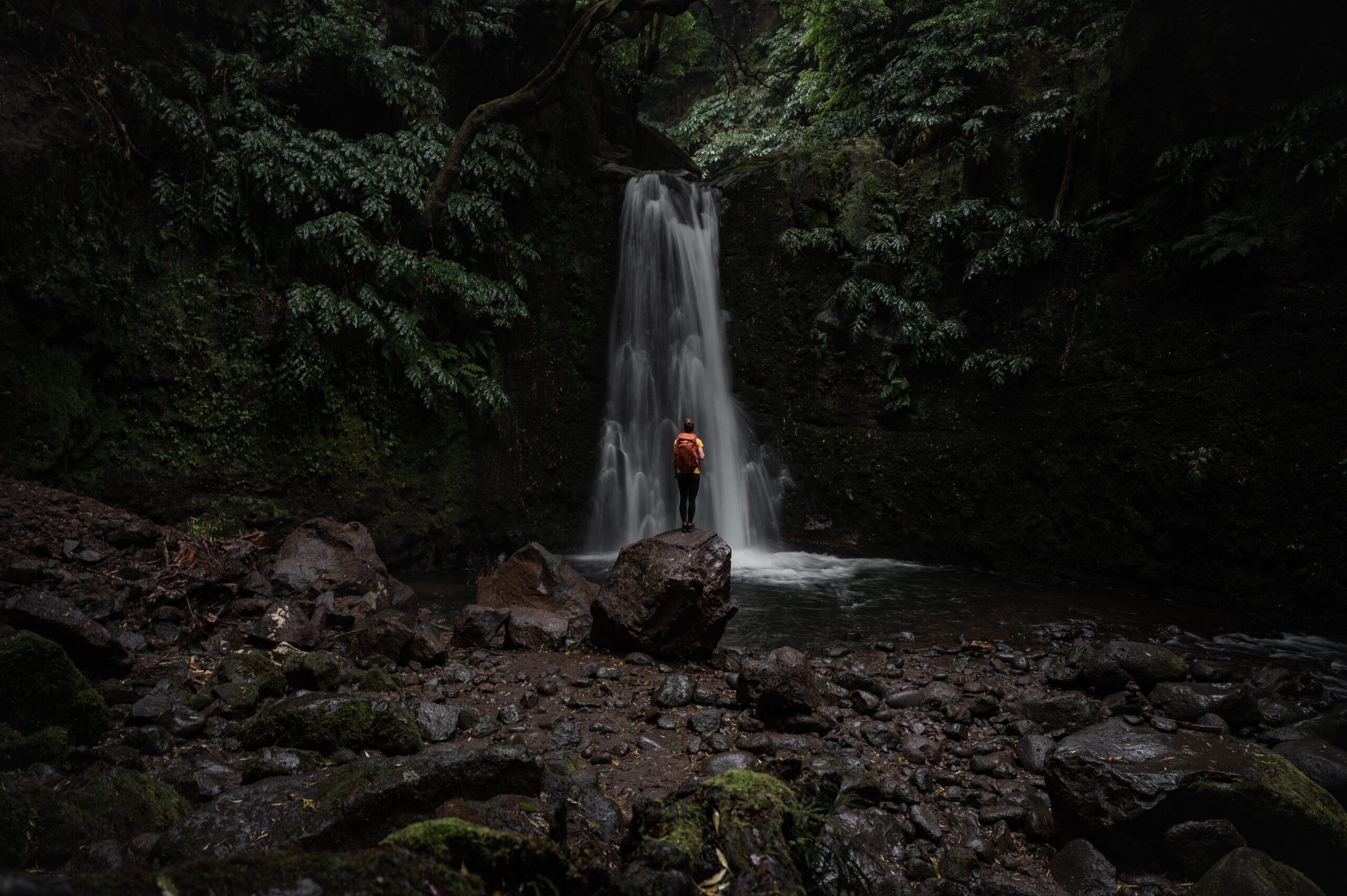





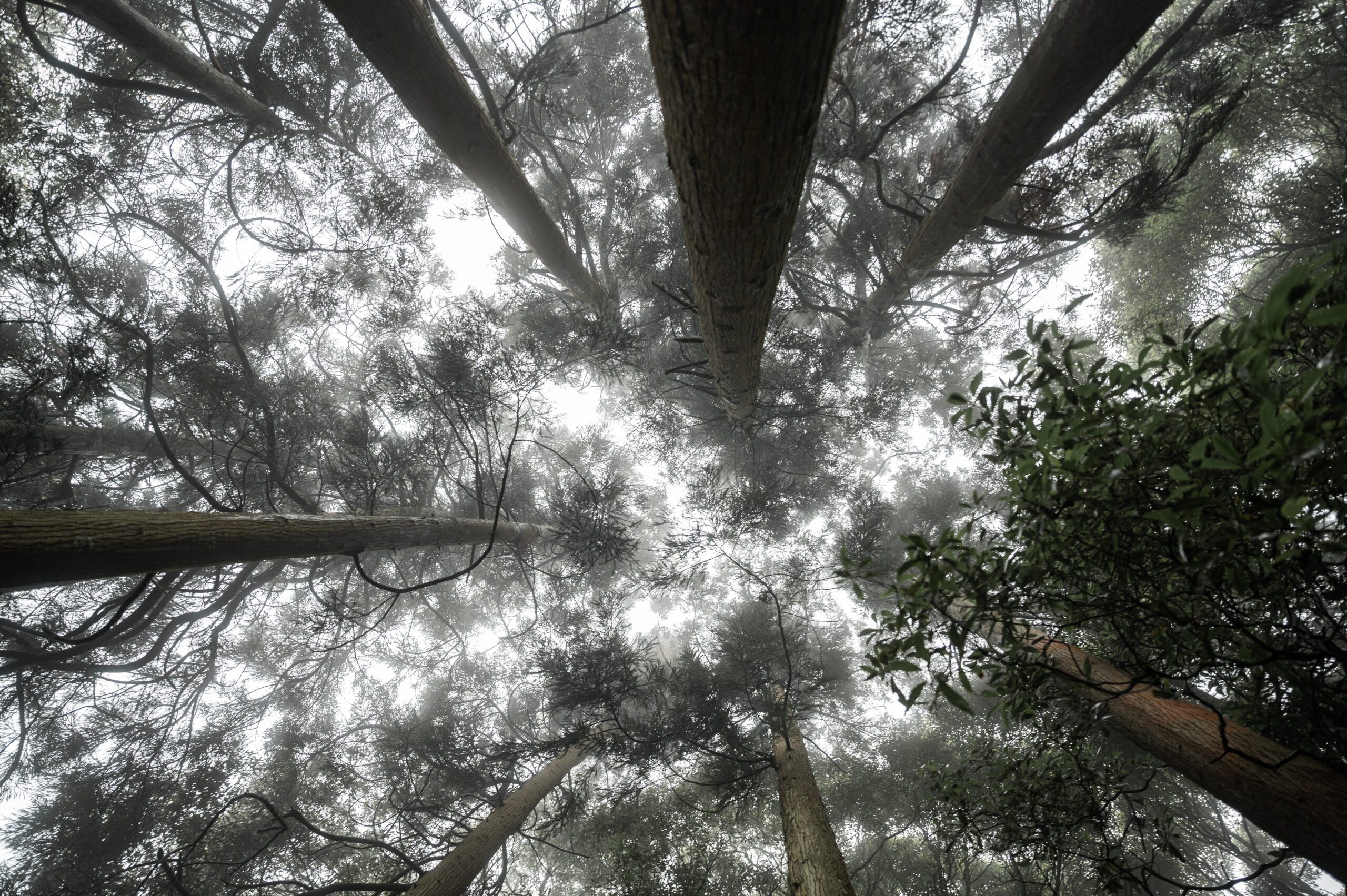



7 Cascata da Ribeira Quente
Although the Ribeira Quente waterfall might look like you’d need a machete to reach it, it’s surprisingly right next to the road. However, if you don’t know it’s there, you’ll likely miss it. The waterfall is tucked away between two short tunnels, and even if you’re looking for it, it flashes by in less than half a second while driving. I only discovered it thanks to a tip from someone, so now I’m passing it along as a secret, crowd-free waterfall.
Park just before the first tunnel (heading down toward the coast) and walk through it—just watch out for cars. There aren’t many, but it’s still a good idea to turn on your phone flashlight. There’s no official path to the base of the waterfall (otherwise, it wouldn’t be a secret, right?), but there’s a faint trail, so you shouldn’t have to bushwhack. Part of the way follows the riverbed, which you can hop across on stones, but be prepared to possibly get your feet a little wet.
The walk from the parking spot is about 300 meters.

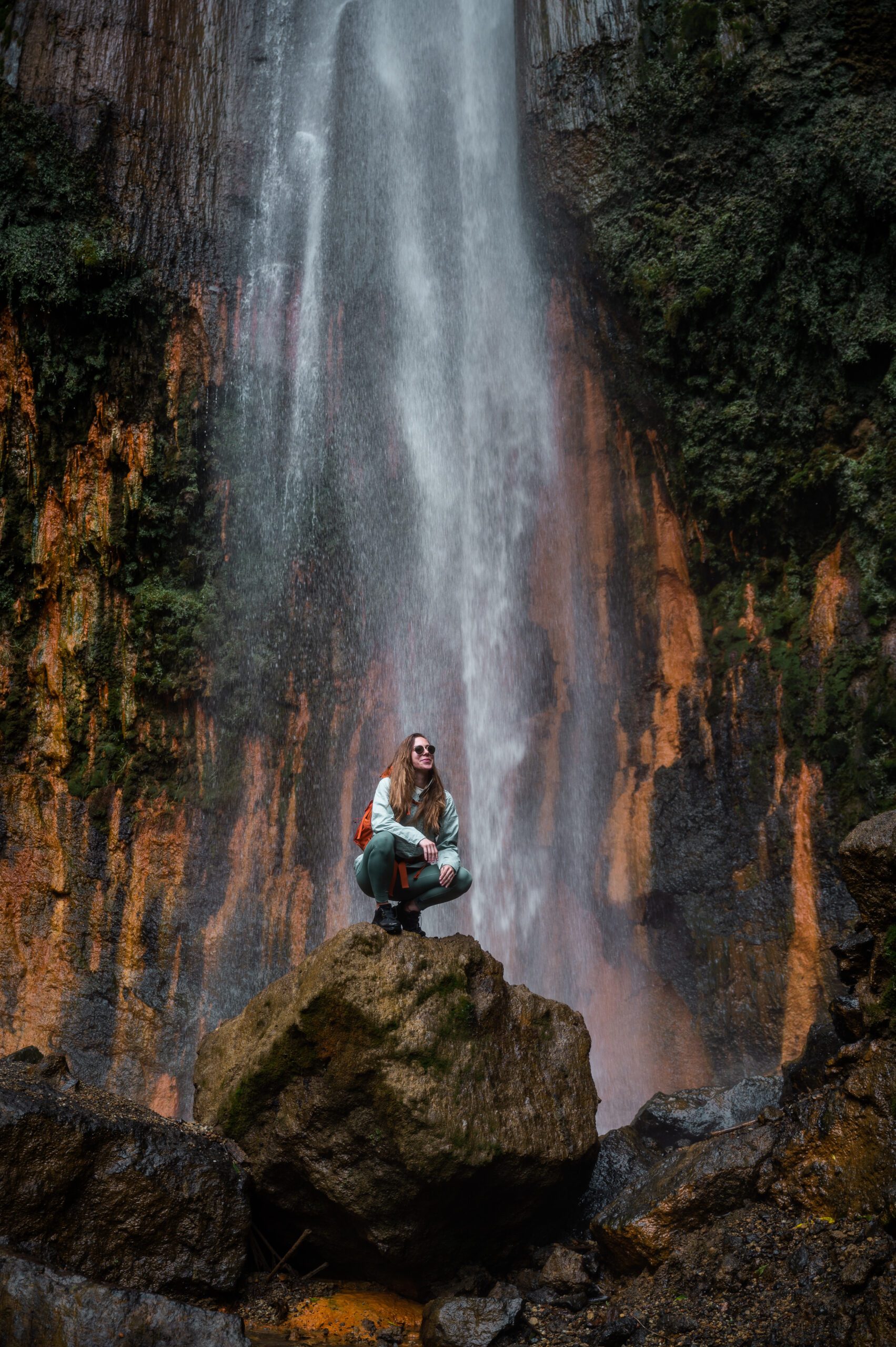

8 Farol do Arnel
There are plenty of lighthouses on the Azores, as you’d expect. Farol do Arnel is perched on a rocky promontory at the very eastern tip of São Miguel. Based on the map, I’d even say it’s the easternmost point of the island. You can drive down to it via a ridiculously steep and winding road, but there’s a sign at the top advising tourists to walk down instead.
In my opinion, though, the lighthouse looks better from a distance. For photos, I recommend either using a drone (😁). You can also head to the nearby Miradouro da Vista dos Barcos. It offers a great view of the lighthouse surrounded by dramatic cliffs (the last photo).
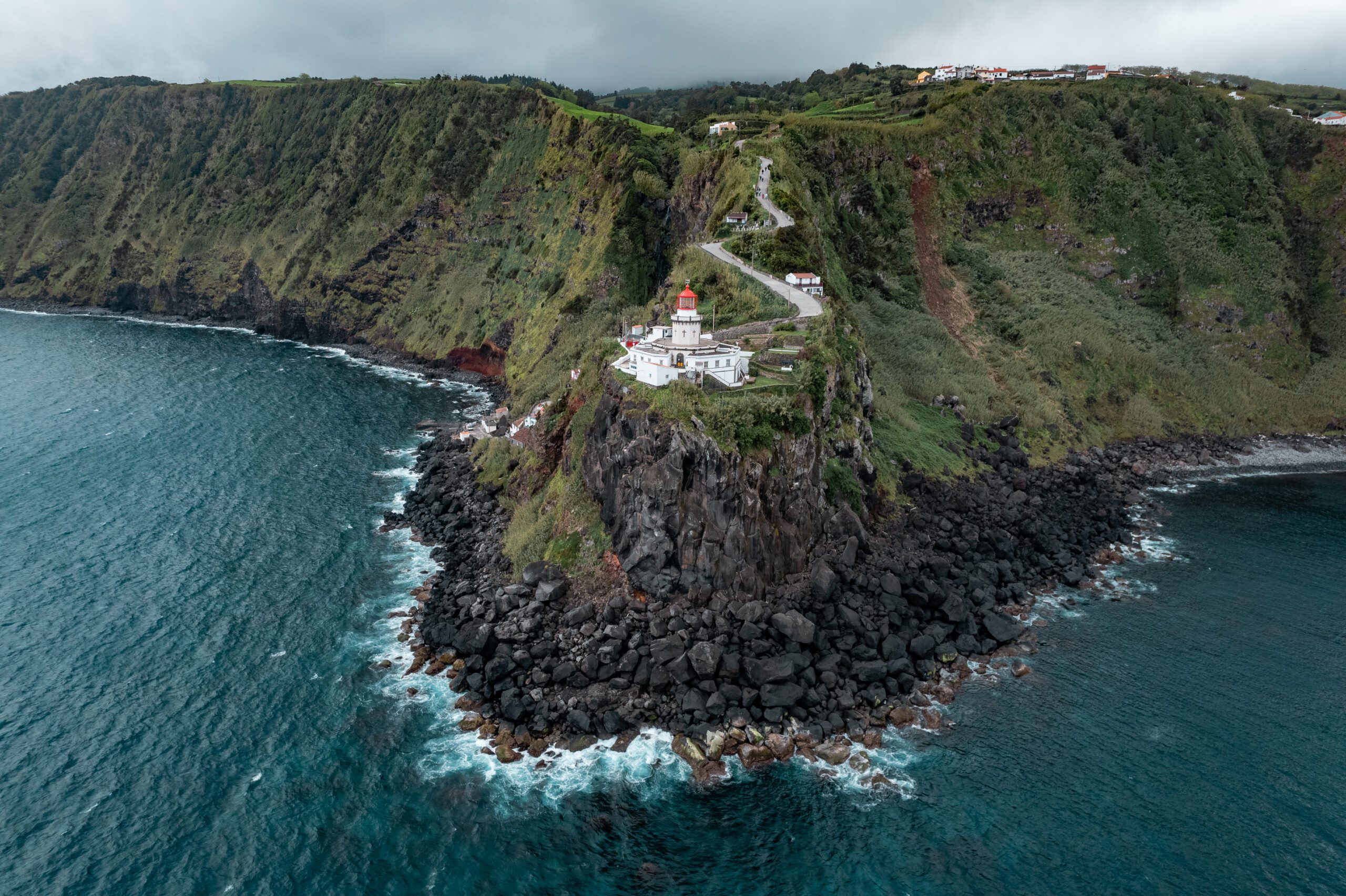


9 Gorreana Tea Factory
Did you know that the oldest and largest tea plantation in Europe is located right here on São Miguel?
To be fair, it’s probably not that hard to be the largest tea plantation, since tea isn’t widely grown in Europe. But we were still impressed—especially considering we’ve seen massive plantations in Sri Lanka and Vietnam. The neatly arranged garden is open to the public, and you can wander around freely.
You can also pair your visit with a tour of the factory, where you’ll learn about the growing and production process. And of course, you’ll get to sample the tea!

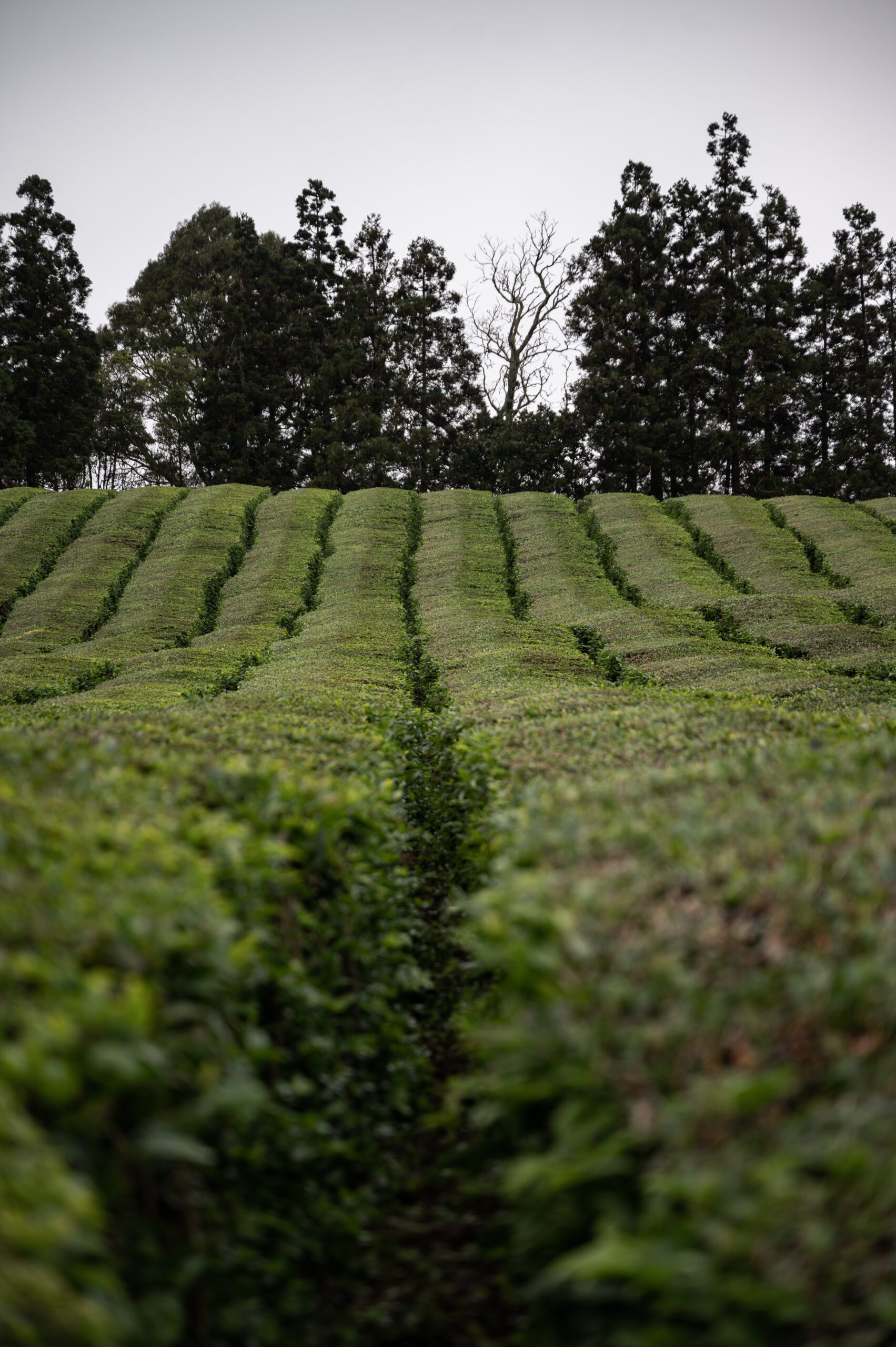


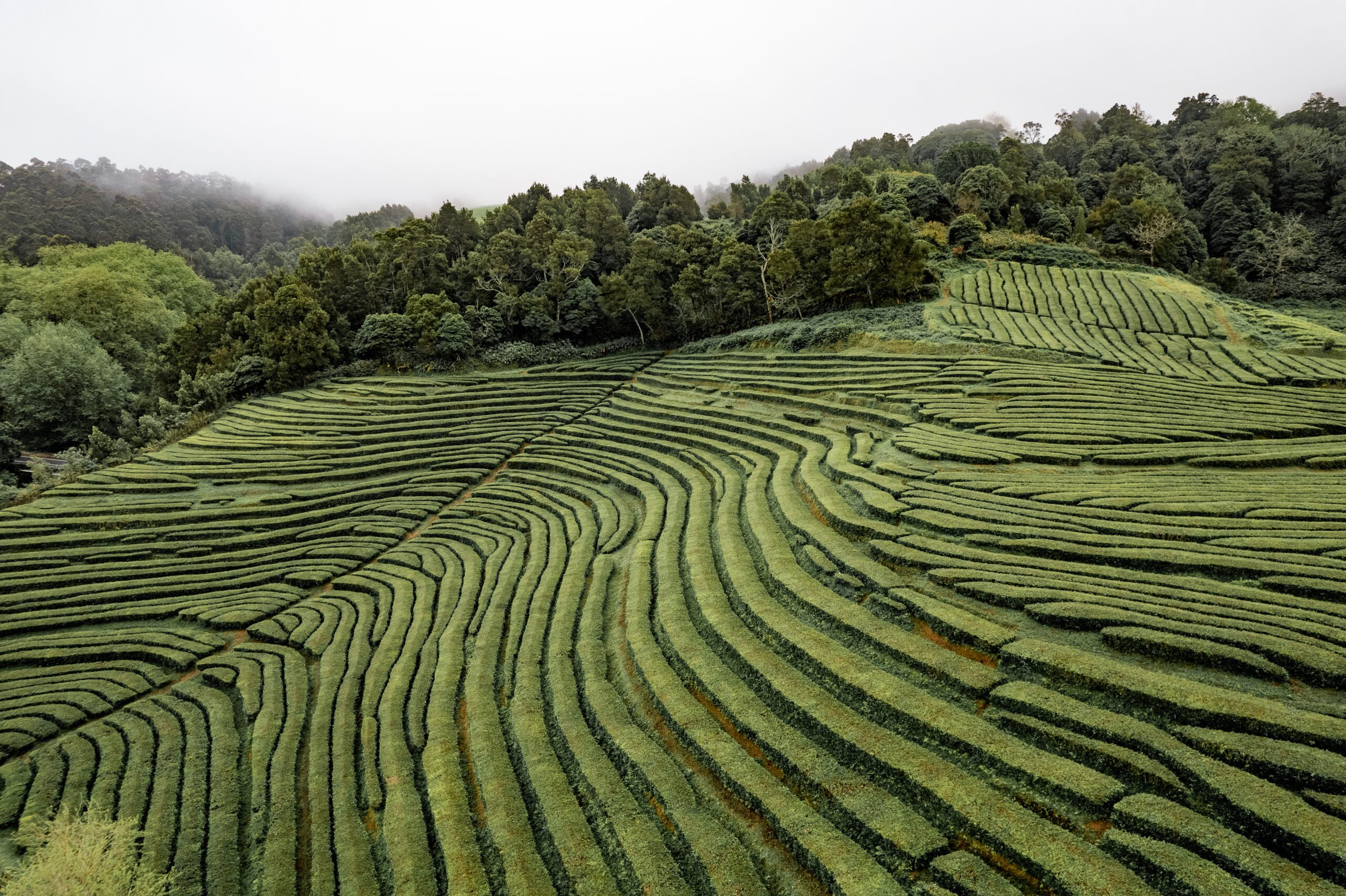
10 Parque Terra Nostra
The expansive botanical gardens of Parque Terra Nostra were established over 200 years ago. Furnas Valley is actually the crater of a dormant volcano, which means geothermal activity creates ideal conditions for a wide variety of flora to thrive.
Stroll along the manicured paths and discover plants you’ve probably never seen before. The gardens also feature several well-maintained ponds, a palm tree avenue, a flower garden, various statues, and—without a doubt—the highlight: soaking in a geothermal pool.
There is an entrance fee, but trust me, it’s absolutely worth it! 🙂





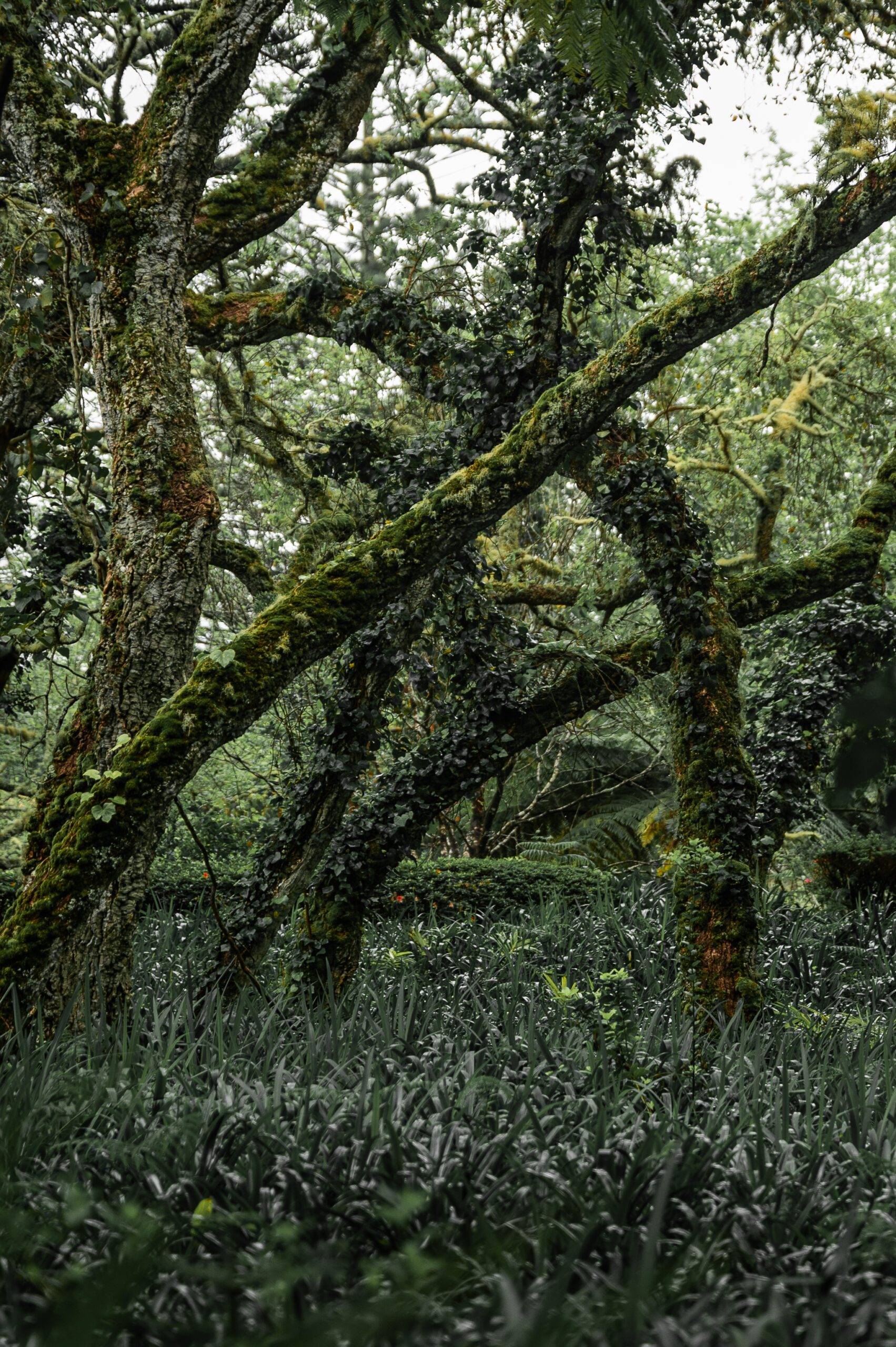










11 Caldeiras das Furnas
These calderas are small rainwater lakes formed in the craters of a dormant volcano after its last eruption in 1630. The accumulated rainwater reaches very high temperatures due to magma being so close to the Earth’s surface in this area. Known as fumaroles, you can now explore them via wooden walkways.
The park is also home to the tradition of the local volcanic dish, Cozido das Furnas. Beef and vegetables are placed in a pot, buried near the hot springs, and slowly cooked by volcanic steam. You can try Cozido at the restaurant right next to the steaming fumaroles—it’s absolutely fantastic!
There is an entrance fee to the park (€3 per person as of 2023).
While you’re here, I recommend combining your visit with the nearby nature reserve, which can be accessed from the restaurant. There’s an additional entrance fee (payable by card at a machine), but it’s totally worth it. You can hike all the way to the Salto da Inglesa waterfall, which was truly impressive after the rain.

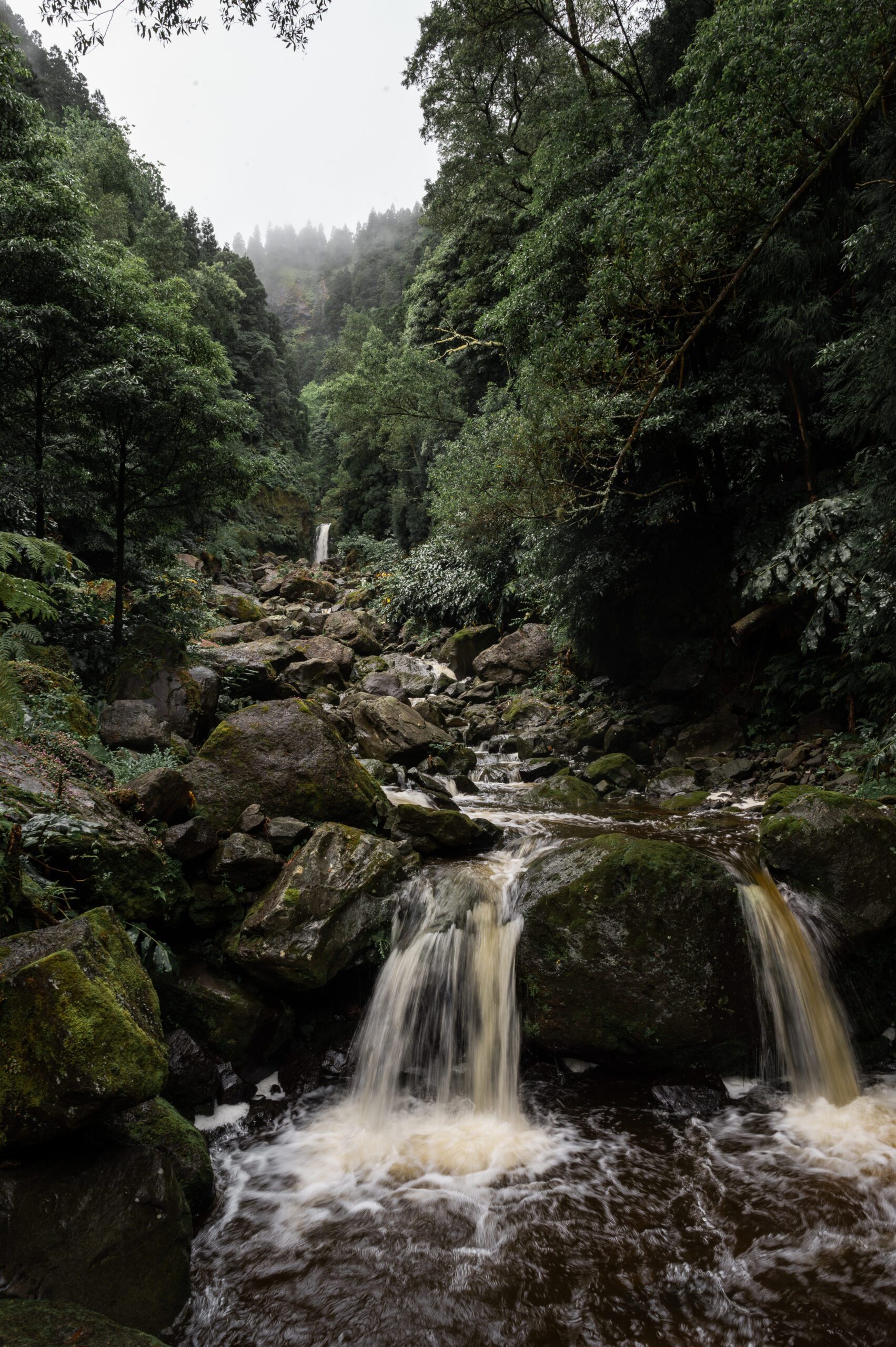







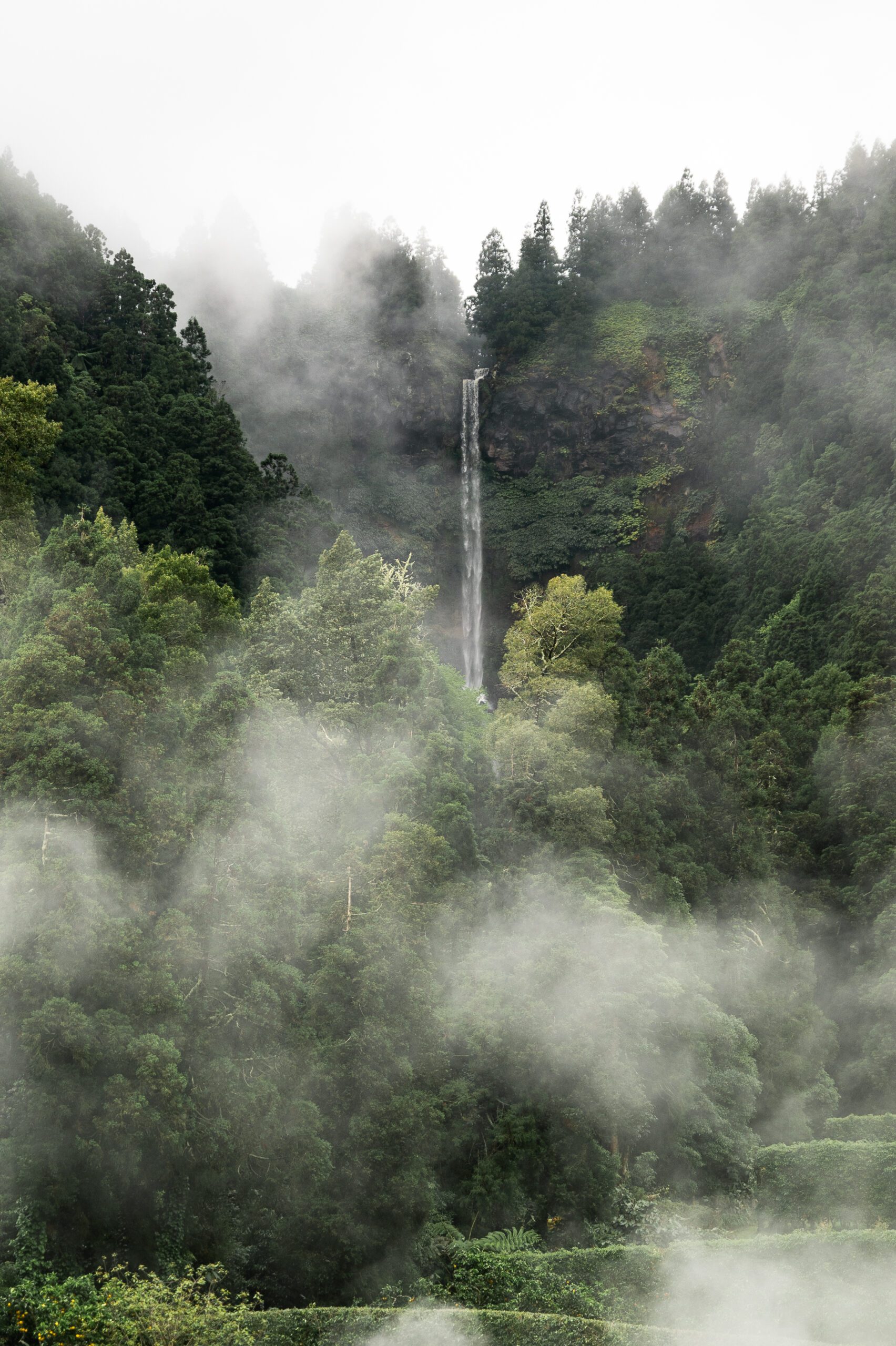
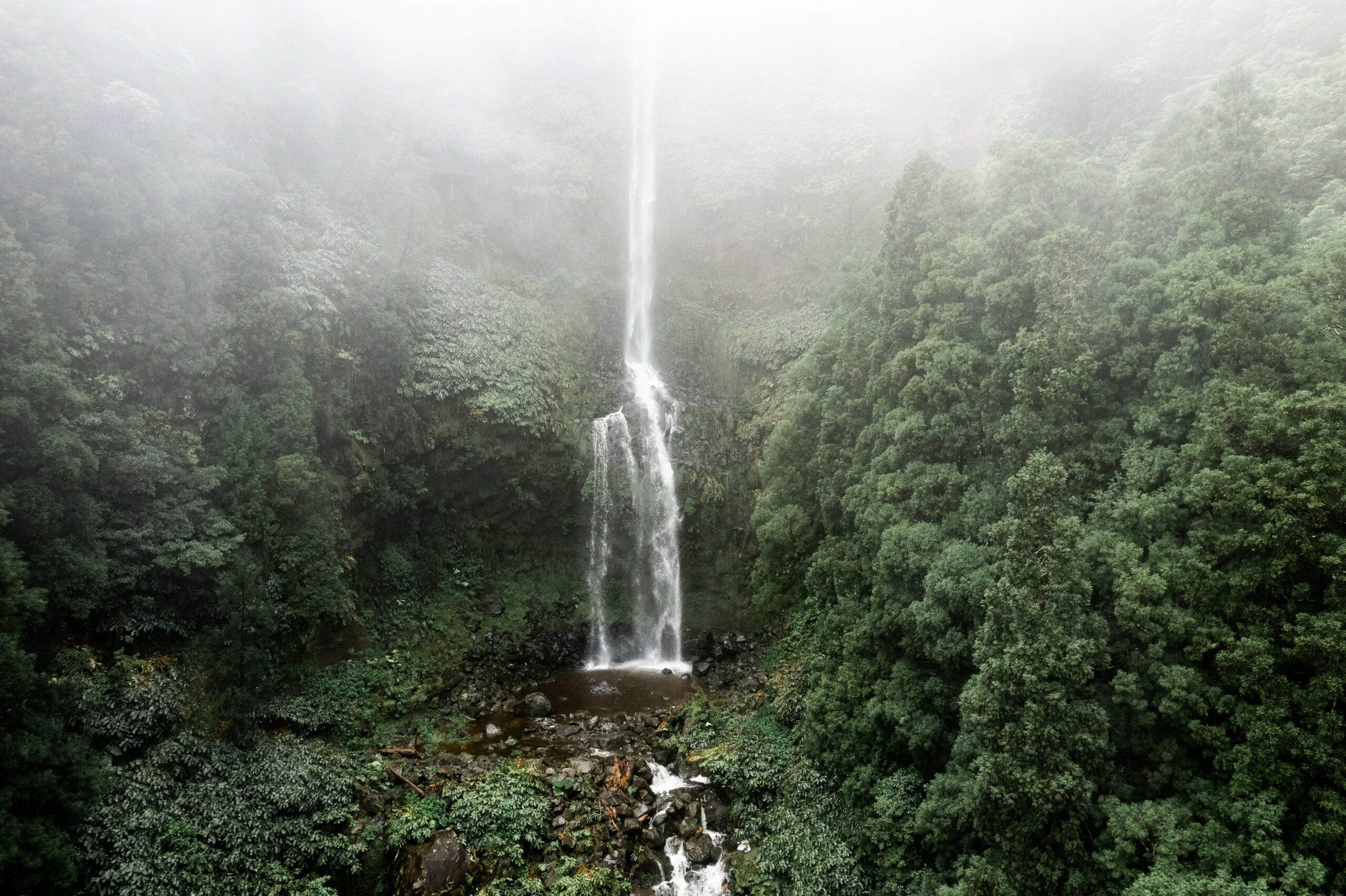
12 Cascata do Salto do Cabrito
Another stunning waterfall, Cascata do Salto do Cabrito, actually consists of two waterfalls. There are various metal walkways and ladders around it, allowing you to explore the area and even take a look into the canyon where the water flows into the falls.


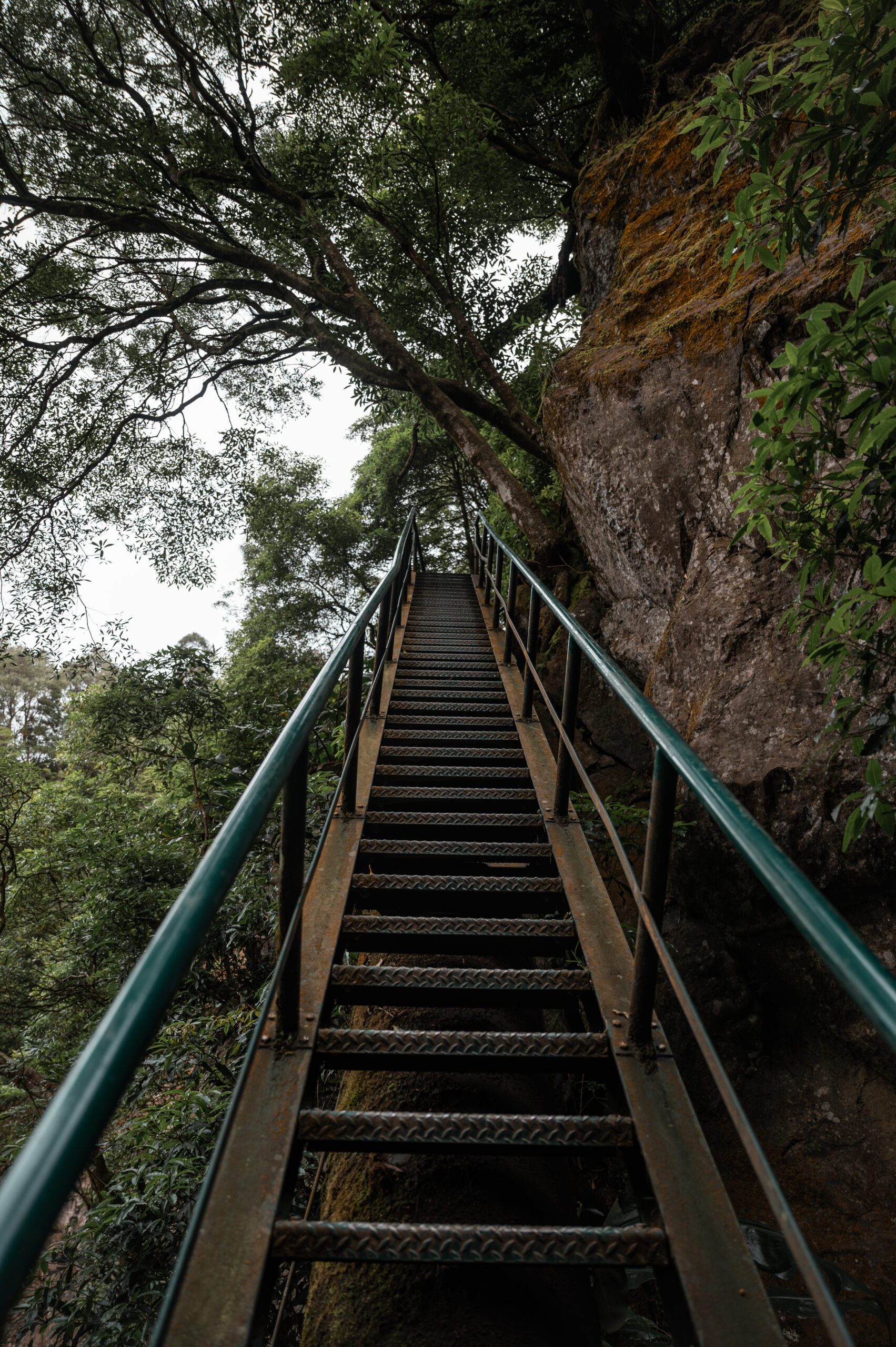





13 Parque Natural da Ribeira dos Caldeirões
Parque Natural da Ribeira dos Caldeirões is a small, beautifully maintained park that’s home to several historic water mills and two stunning waterfalls. The waterfalls are just 600 meters apart and easily accessible via walking trails and pathways.
Surprisingly, entry to the park is free.







14 Mosteiros Beach
Mosteiros Beach is considered the most beautiful beach on São Miguel Island, and I can’t disagree. Its uniqueness lies in the striking rock formations rising from the water. They’re not far from the shore, so in summer, you can even swim out to them. 🙂




15 Caldeira Velha
Caldeira Velha is a small nature reserve featuring waterfalls and thermal pools perfect for swimming. Unfortunately, during our visit, the pools were drained due to bad weather, so we didn’t get to take a dip, but it’s said to be an amazing experience.
There’s an entrance fee, even if you don’t plan to swim.
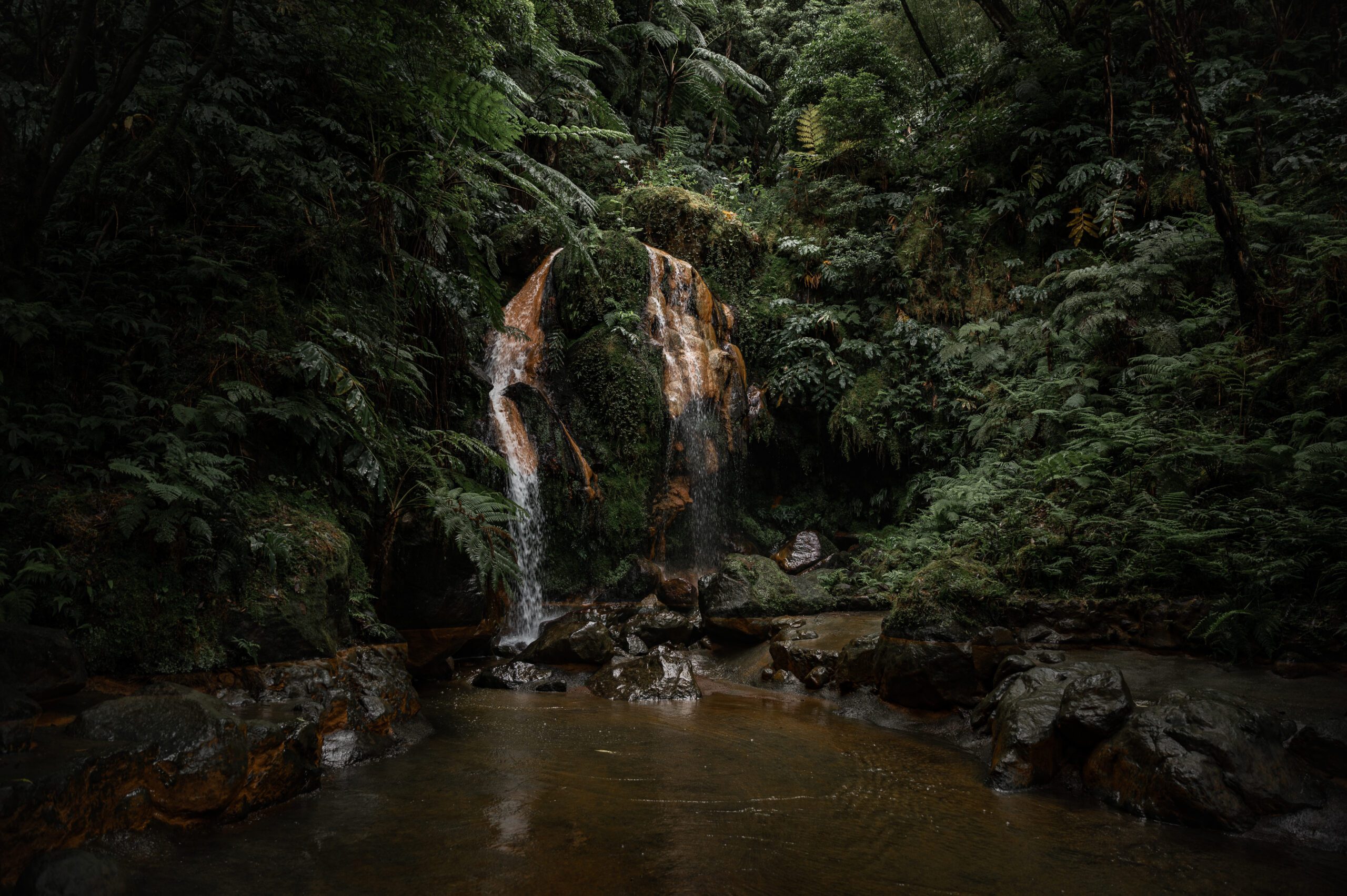







16 Ponta da Ferraria
The natural swimming spot Ponta da Ferraria is a small cove tucked away on the western tip of the island. Located right on the shore, it offers the most natural thermal spring experience on São Miguel. It’s also the only hot spring within the volcanic complex of Sete Cidades.
The water in this thermal pool is heated by the surrounding lava rocks and a natural geothermal spring beneath them. I read somewhere that you need to be cautious during low tide, as some spots can overheat if they aren’t mixed with the cooler seawater. The water temperature here typically ranges from a cool 18°C to a more comfortable 30°C.
Access to the ocean is, of course, free.





17 Poço Azul
Poço Azul is a small pond with a waterfall and a few pools where you can swim. There’s also a small cave to explore. The name Poço Azul translates to “Blue Well,” but the water was far from blue during our visit, likely due to the weather.

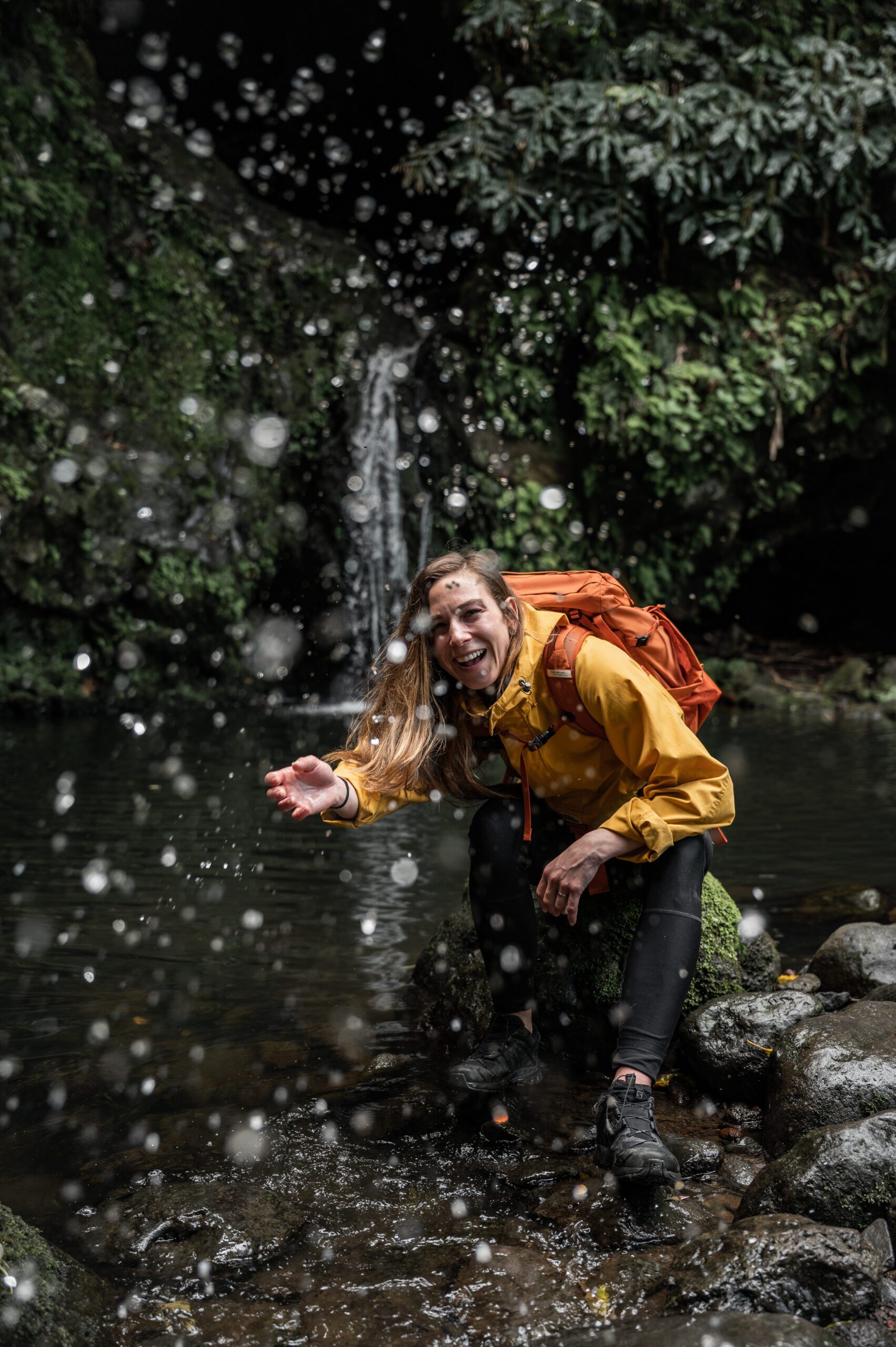

18 Lagoa Pau Pique
This caldera with a small lake probably won’t be mentioned in any guidebook. There’s no path leading to it, and it doesn’t seem to attract much attention from tourists. So why did we check it out? Because it was on the way to Sete Cidades and the last spot before Lagoa do Canario that wasn’t completely swallowed by fog. We managed to snap a photo with the drone, but from the ground, it’s not exactly a breathtaking view.


19 Miradouro da Ponta da Madrugada
We loved this viewpoint for two reasons: first, the cliffs, which slightly resemble Hawaii’s Napali Coast. The second reason? The barbecue spots, which you’ll actually find at almost every viewpoint on the island. Each miradouro is equipped with stone tables, benches, and grills—you just need to bring some charcoal and something tasty to cook. During the summer months, it must be incredibly romantic since most of these picnic areas come with spectacular ocean views.
We didn’t barbecue (because it was 10°C 😂), but this picnic spot was our absolute favorite. It’s multi-leveled, so every table offers a stunning view. Not to mention the soft moss covering the ground and benches, making the whole place feel magical.







20 Miradouro de Santa Iria
Another stunning viewpoint awaits you along the northern coast. Here, you’ll get a slightly different perspective of the rocky cliffs. The view spans 180 degrees, so I’d say it’s also a great spot to catch the sunset!



21 Ermida de Nossa Senhora da Paz
One of the most famous landmarks in the Azores is the pilgrimage site Ermida de Nossa Senhora da Paz, or the Chapel of Our Lady of Peace. Perched on a hill above the town of Vila Franca do Campo, it offers breathtaking views of the coastline—assuming the thick fog doesn’t get in the way :D.
The chapel was built in 1764, and its iconic white staircase is decorated with traditional azulejos—blue-tiled artwork.
Access to the staircase and the chapel is free. However the interior is often closed and only opens during religious ceremonies.
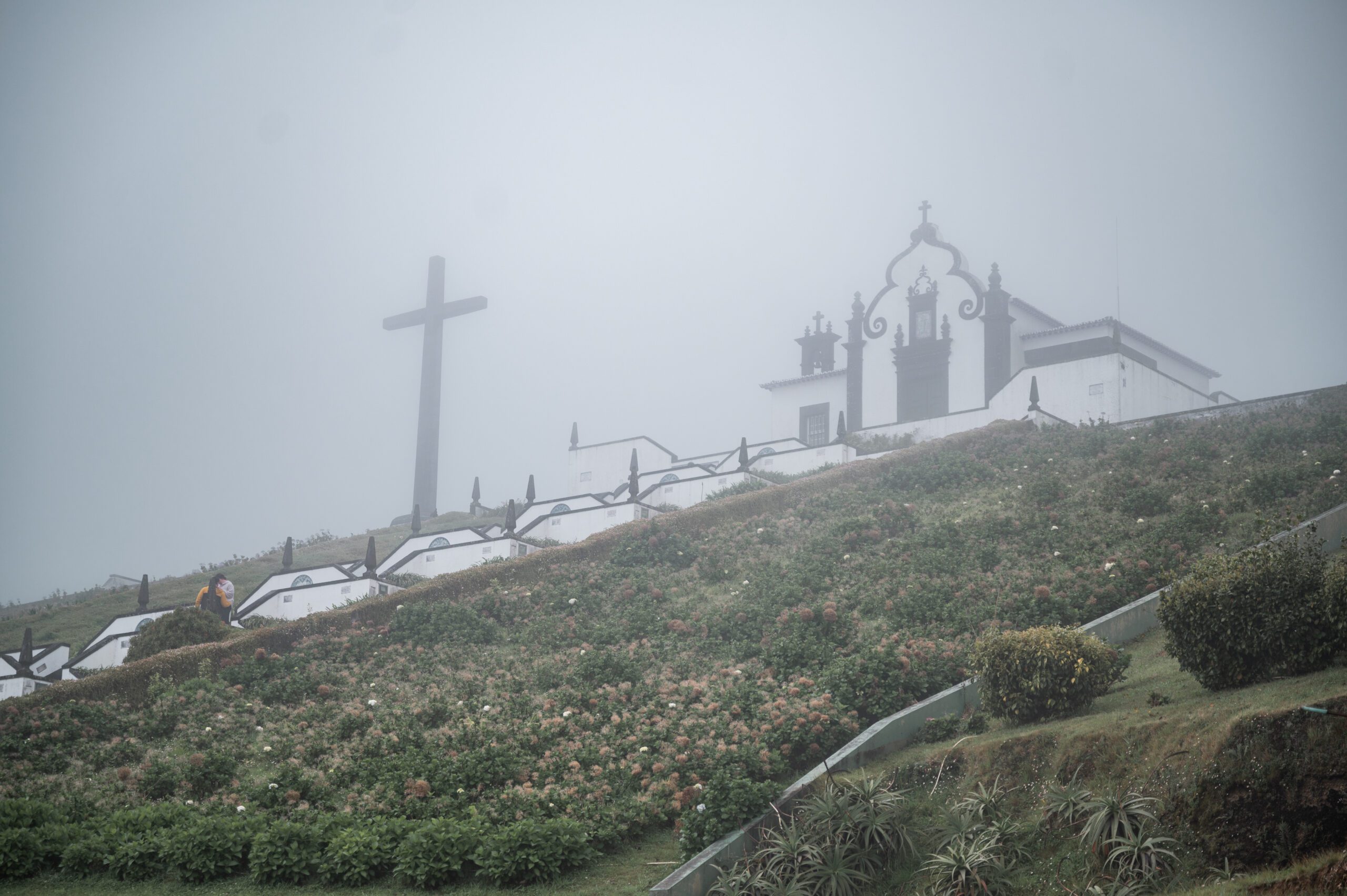




22 Miradouro da Ilha Sabrina
Miradouro da Ilha Sabrina is a newly renovated viewpoint overlooking the cliffs of Ponta da Ferraria on one side and a lighthouse on the other. And yes, they didn’t forget the picnic tables here either!





23 Capela de Nossa Senhora das Vitórias
You’ll find a magical funeral chapel from 1886 in the park on the shores of Furnas Lake. Its iconic red bricks, covered in lichen, give the structure a unique, almost otherworldly vibe. The surrounding park is also worth a stroll.
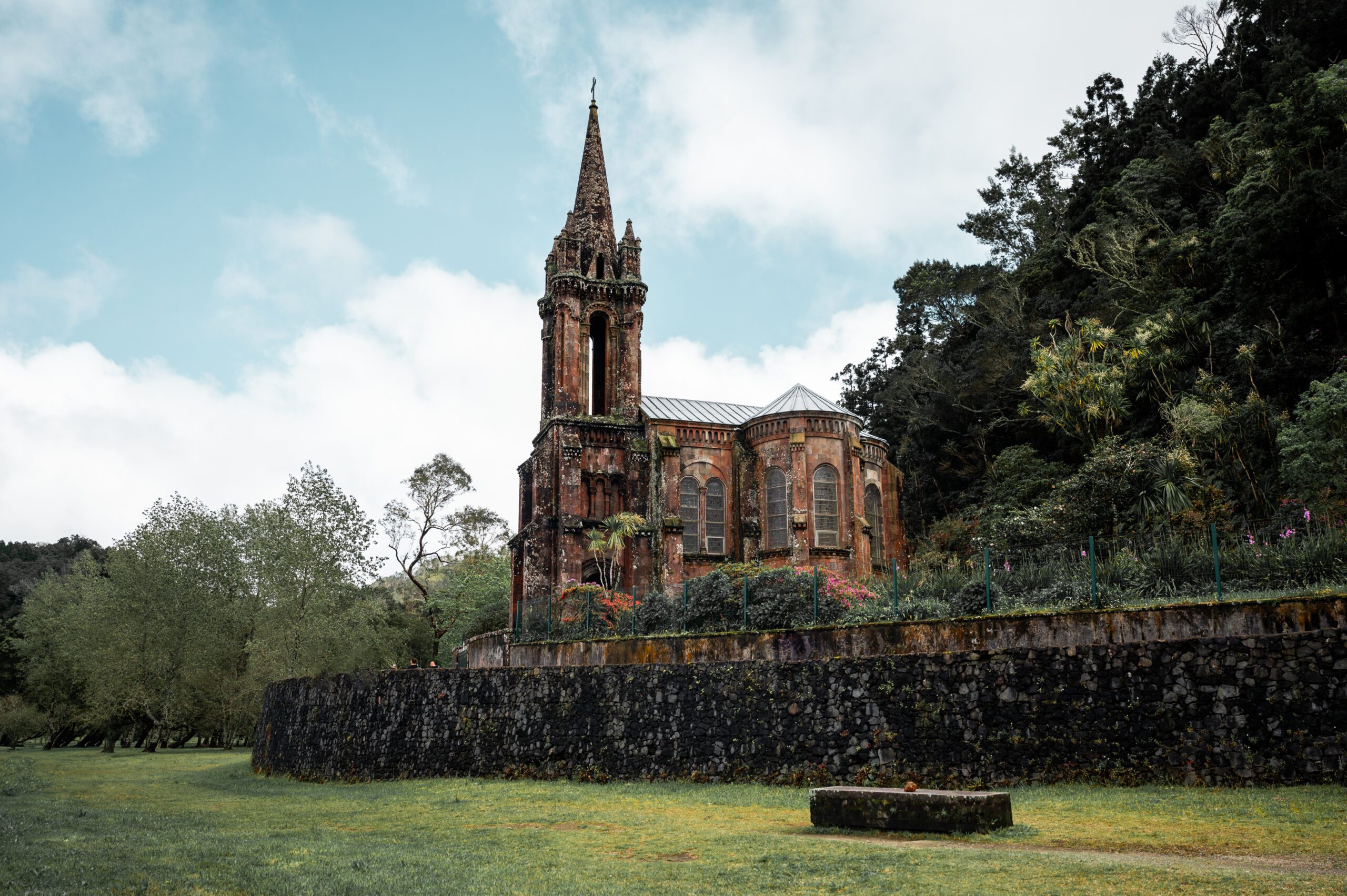

24 Portas da Cidade & Igreja de São Sebastião
A stroll through the capital city will only take about two hours. The main landmarks include the city gates and the Igreja de São Sebastião church—both located on the main square in the heart of town.



25 Arquipélago
If you’re into modern architecture and art, don’t miss the Museum of Modern Art. This concrete architectural gem is located in the town of Ribeira Grande.

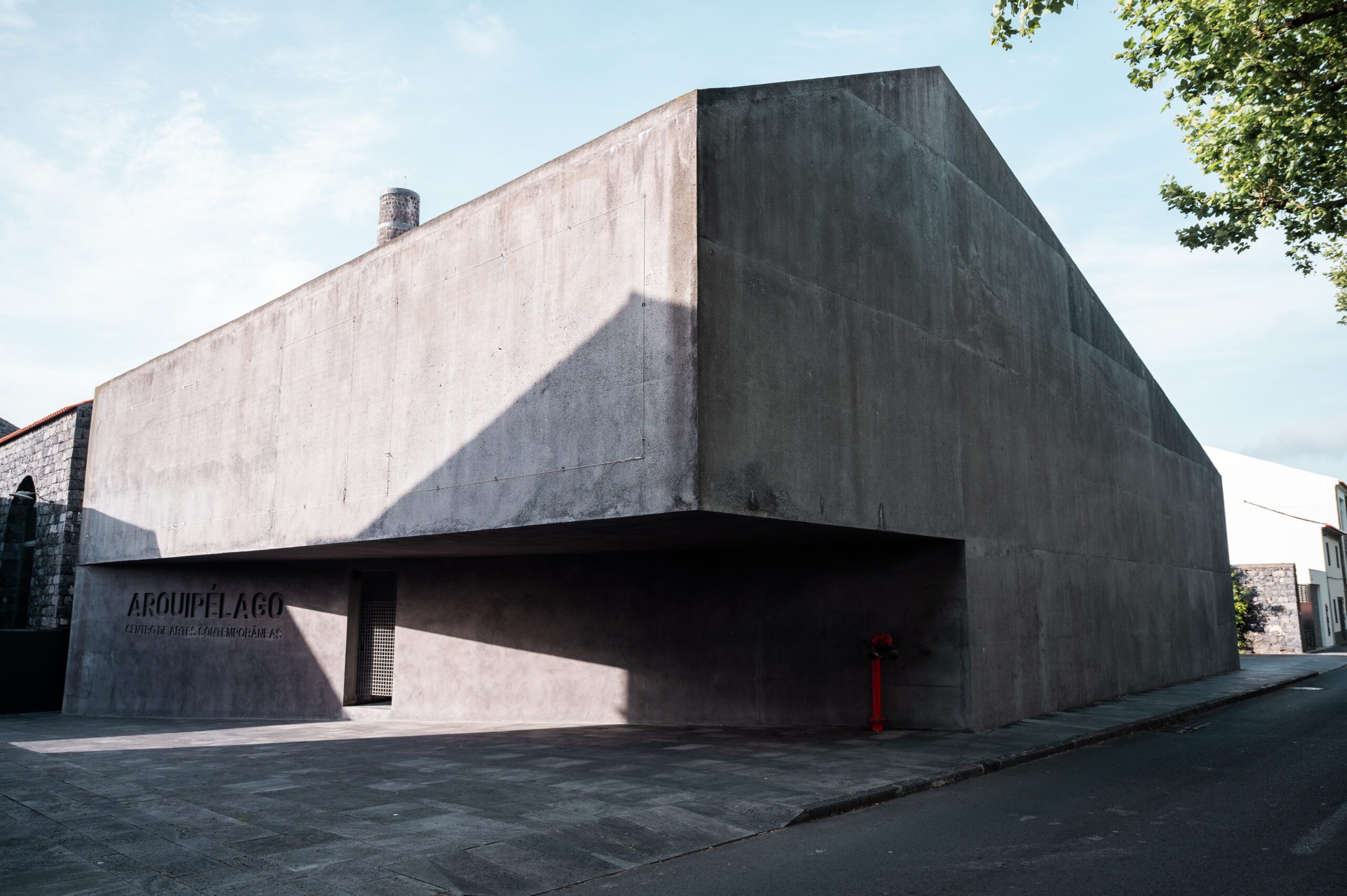


26 Dům vzhůru nohama (Casa Invertida)
Another very unconventional structure can be found just outside the town of Furnas. We learned that it’s not a residential building but houses a transformer for an electric company. It’s probably not something that draws tourists to the Azores, but it’s definitely not something you see every day!
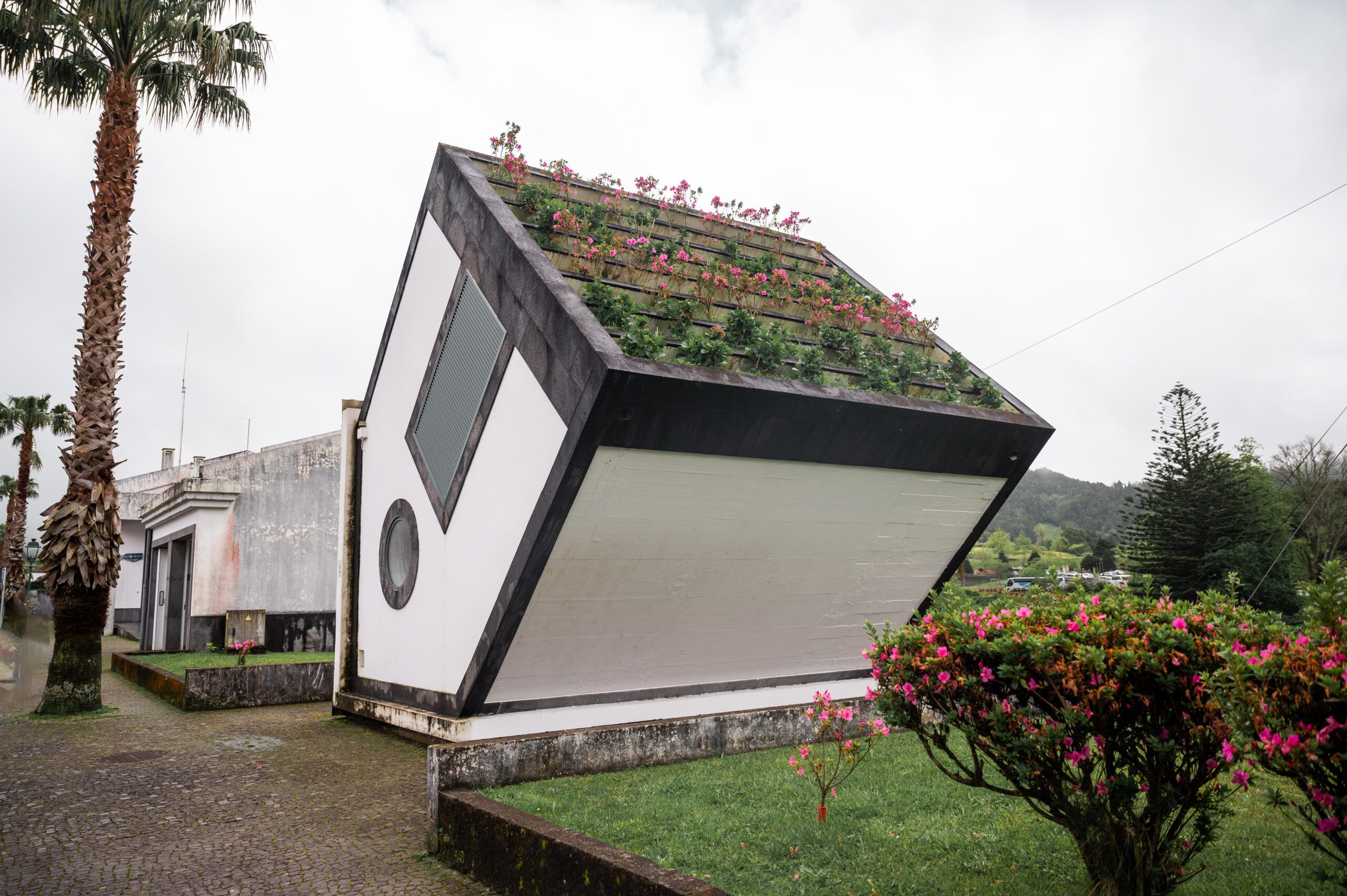
27 Plantação de Ananás dos Açores
My list wouldn’t be complete without a rainy-day option in case the weather doesn’t play along with your plans. You can visit a pineapple plantation located right in the heart of Ponta Delgada. Yes, you read that correctly—a plantation tucked between city buildings! 🙂
You can wander through the greenhouses for free, watch videos about pineapple cultivation, and even get a taste of pineapple jam and juice at the end.





28 Pozorování velryb
The Azores are a perfect destination for whale and dolphin watching. Instead of using sonars or radars to locate them, they rely on an old traditional method—spotting them with binoculars from the cliffs. They have great respect for the whales here, so none of the companies feed them to lure them closer to the boats or chase them across the ocean.
We were lucky enough to spot a mother and her calf, though I don’t have any photos to show for it. It was always just a fleeting moment when they surfaced, and I preferred watching them with my own eyes rather than fumbling with my camera. After 15 minutes, we had to leave the area to avoid stressing them out.
We went with Futurismo and were very happy with the experience.
P.S.: If you go with them, don’t turn up your nose at their waterproof jackets. We went out on a pretty windy day, and even in our Gore-Tex gear, we were soaked to the skin. 😁




To wrap things up, here’s a recommendation for an amazing restaurant we loved so much we went back three times. The food was delicious, the cocktails were fantastic, and the bistro is located right on Santa Barbara’s surfer beach, making for a great vibe! Definitely stop by if you can. The restaurant is called TukáTulá Beach Bar.





We also really enjoyed Michel Restaurant, although I unfortunately don’t have any photos from there. It’s a bit more traditional and slightly pricier.
If you liked this article about the Azores, be sure to check out my article on Madeira to compare these two destinations. Personally, I found them quite similar, with the difference being that Madeira has taller, more dramatic mountains, while the Azores win when it comes to volcanoes and calderas.
Happy travels!
E.


